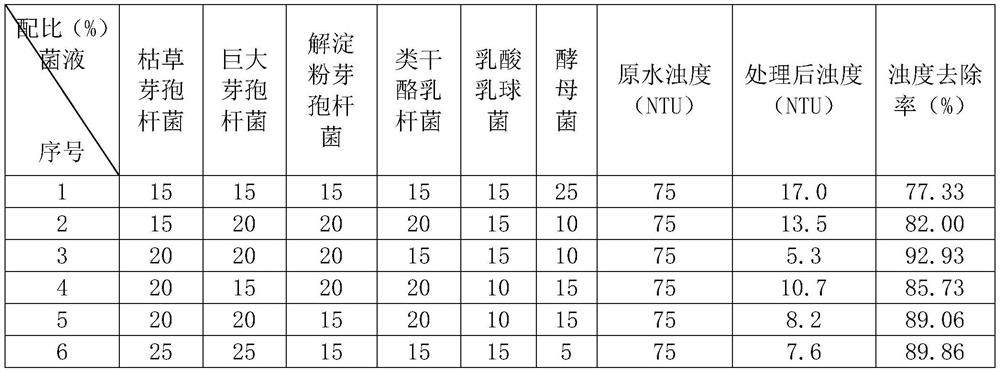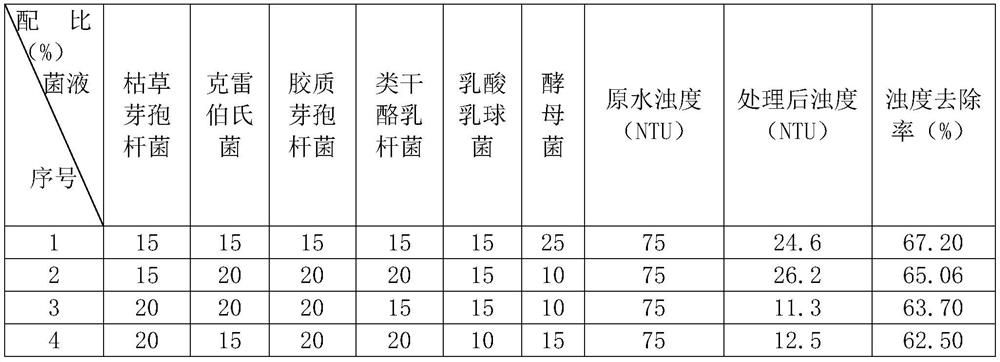Composite microbial flocculant for raw tap water treatment and its preparation and use method
A technology of compound microorganisms and flocculants, applied in biological water/sewage treatment, water/sludge/sewage treatment, chemical instruments and methods, etc. problem, to achieve the effect of ensuring the flocculation effect
- Summary
- Abstract
- Description
- Claims
- Application Information
AI Technical Summary
Problems solved by technology
Method used
Image
Examples
preparation example Construction
[0034] The preparation method of the composite microbial flocculant used for tap water raw water treatment comprises the following steps:
[0035] Step 1. Strain preparation: prepare one strain each of Bacillus subtilis, Bacillus megaterium, Bacillus amyloliquefaciens, Lactobacillus paracasei, Lactococcus lactis, and saccharomyces;
[0036] Step 2, strain activation: Bacillus subtilis, Bacillus megaterium, and Bacillus amyloliquefaciens are activated into original species with nutrient gravy liquid medium (for example, LB broth medium) respectively; Lactobacillus casei, Lactococcus lactis respectively Activate the original species with lactic acid bacteria liquid medium; activate the original species with wort liquid medium for yeast;
[0037] Step 3. Expansion of culture: Inoculate the original seed liquid activated in the above steps into the corresponding medium for shaking culture, and then ferment in batches in a fermenter. When the total number of microorganisms is great...
experiment example 1
[0039] Experimental case 1: Bacterial liquid ratio test
[0040] According to the orthogonal experiment design and comprehensive consideration of factors such as the cultivation process, the experimental design and data of the ratio of bacteria in the raw water treatment of tap water are shown in Table 1:
[0041] Table 1 Bacterial Solution Proportion Comparison
[0042]
[0043]
[0044] It can be seen from the first group of experiments in Table 1 that when the proportion of saccharomycetes exceeds 20%, due to the excessive saccharomyces, it is easy to produce alcohols, inhibit the growth of other bacterial species, and the coordination effect is not good; the final flocculation The turbidity removal rate of the agent is relatively low, only 77.33%.
[0045]It can be seen from the experiments of groups 6 and 7 in Table 1 that when the proportion of yeast is less than 10%, the turbidity removal rate reaches more than 88%, which is relatively high. However, the cost in...
experiment example 2
[0053] Experimental case 2: application test of composite microbial flocculant
[0054] The flocculant is continuously added to the tap water raw water treatment simulation device. The total amount of flocculant is 0.05% of the tap water raw water intake. The residence time of the raw water in the design reaction sedimentation tank is 2 hours. The raw water of the experiment is the raw water of the Yangtze River. Monitor and detect the turbidity of water quality before and after adding the compound microbial flocculant, see Table 3:
[0055] Table 3 Index before and after adding compound microbial flocculant
[0056] project Turbidity (NTU) Turbidity removal rate (%) CODcr removal rate (%) Raw water from the Yangtze River 56.7 0 0 Water out before dosing 40.8 28.04 14.6 Water after dosing 2.3 95.94 68.7
[0057] It can be seen from Table 3 that after adding the composite microbial flocculant, the removal rate of turbidity reached 95....
PUM
 Login to View More
Login to View More Abstract
Description
Claims
Application Information
 Login to View More
Login to View More - R&D
- Intellectual Property
- Life Sciences
- Materials
- Tech Scout
- Unparalleled Data Quality
- Higher Quality Content
- 60% Fewer Hallucinations
Browse by: Latest US Patents, China's latest patents, Technical Efficacy Thesaurus, Application Domain, Technology Topic, Popular Technical Reports.
© 2025 PatSnap. All rights reserved.Legal|Privacy policy|Modern Slavery Act Transparency Statement|Sitemap|About US| Contact US: help@patsnap.com



